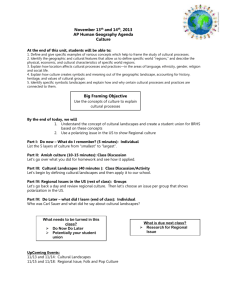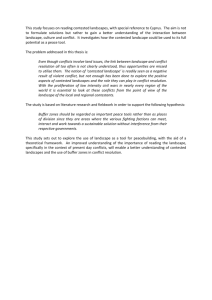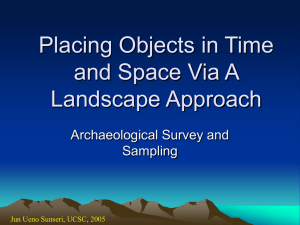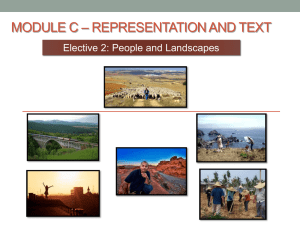to the PDF. - Country Land and Business Association
advertisement
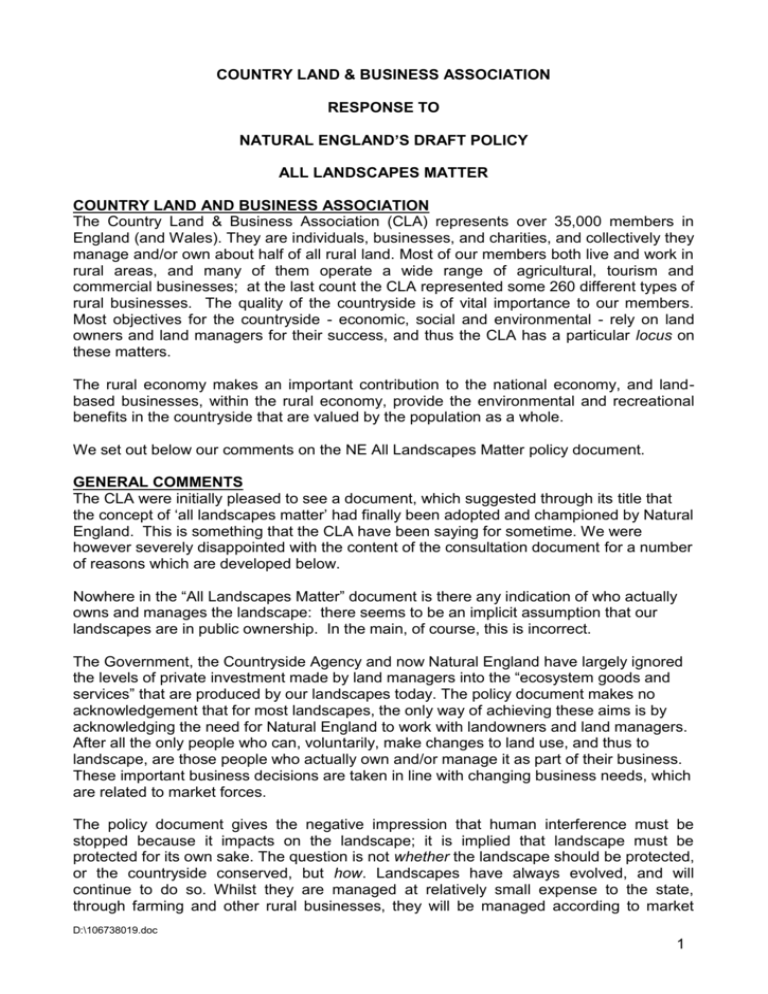
COUNTRY LAND & BUSINESS ASSOCIATION RESPONSE TO NATURAL ENGLAND’S DRAFT POLICY ALL LANDSCAPES MATTER COUNTRY LAND AND BUSINESS ASSOCIATION The Country Land & Business Association (CLA) represents over 35,000 members in England (and Wales). They are individuals, businesses, and charities, and collectively they manage and/or own about half of all rural land. Most of our members both live and work in rural areas, and many of them operate a wide range of agricultural, tourism and commercial businesses; at the last count the CLA represented some 260 different types of rural businesses. The quality of the countryside is of vital importance to our members. Most objectives for the countryside - economic, social and environmental - rely on land owners and land managers for their success, and thus the CLA has a particular locus on these matters. The rural economy makes an important contribution to the national economy, and landbased businesses, within the rural economy, provide the environmental and recreational benefits in the countryside that are valued by the population as a whole. We set out below our comments on the NE All Landscapes Matter policy document. GENERAL COMMENTS The CLA were initially pleased to see a document, which suggested through its title that the concept of ‘all landscapes matter’ had finally been adopted and championed by Natural England. This is something that the CLA have been saying for sometime. We were however severely disappointed with the content of the consultation document for a number of reasons which are developed below. Nowhere in the “All Landscapes Matter” document is there any indication of who actually owns and manages the landscape: there seems to be an implicit assumption that our landscapes are in public ownership. In the main, of course, this is incorrect. The Government, the Countryside Agency and now Natural England have largely ignored the levels of private investment made by land managers into the “ecosystem goods and services” that are produced by our landscapes today. The policy document makes no acknowledgement that for most landscapes, the only way of achieving these aims is by acknowledging the need for Natural England to work with landowners and land managers. After all the only people who can, voluntarily, make changes to land use, and thus to landscape, are those people who actually own and/or manage it as part of their business. These important business decisions are taken in line with changing business needs, which are related to market forces. The policy document gives the negative impression that human interference must be stopped because it impacts on the landscape; it is implied that landscape must be protected for its own sake. The question is not whether the landscape should be protected, or the countryside conserved, but how. Landscapes have always evolved, and will continue to do so. Whilst they are managed at relatively small expense to the state, through farming and other rural businesses, they will be managed according to market D:\106738019.doc 1 demands which, in future, will include significant land use change in response to global demands for food and environmental security. Farming remains the dominant land use in rural areas, with grazing livestock seen as integral to landscape management. However grazing livestock enterprises must be viable if they are to continue to exist as part of a farm enterprise. Our most valued habitats and landscapes have resulted from the benign practices and monetary resources of successive land managers who have conserved the landscape for a variety of reasons: scientific, biodiversity, landscape, shooting, historic family ownership, historical pressures etc. Regulation may be able to prevent some undesirable actions, but cannot in itself engage the active and willing commitment of land managers. The variety and distinctiveness of Britain’s landscape depends on the positive decisions of thousands of individuals. Our landscapes have been almost entirely created by man. They are dynamic, working landscapes, and can only be sustained by appropriate positive management which is best delivered by viable agricultural, forestry and rural businesses, especially those that are responsible for the sustainable appearance of the landscape – primarily land owners and land managers. The rural economy of our landscapes is multifunctional, diverse, and dynamic, and is no less subject to change than urban society. The rural economy of our landscapes requires development to modernise as does any modern business in this country. The CLA has long promoted the need to take a balanced approach to “sustainable development” and its three pillars – economy, community, and environment, and this is no less important for our landscapes. The future of our landscapes and the economic success of our rural areas are inextricably linked. A well-managed landscape enriches the nation’s heritage, but is also an attractive backdrop for the much-needed inward investment and tourism and leisure activities. But the landscape is not a free good; its management uses resources which have alternative uses and value. The environmental value of a habitat, a landscape or a historic building must be underpinned either by a public payment for the delivery of public goods/services or by an economic use. Similarly, policies to conserve the richness of our flora, fauna and landscape must therefore work with, not against, the grain of rural business and must be underpinned by evidence and sound science. The countryside is dynamic, and our landscapes are no less subject to change than townscapes. Rural development must include some development, which means change. If we stifle change, whether agricultural, diversification, housing, local employment sites, or tourism, then our landscapes will cease to function as economic and social entities, and the associated environmental and landscape contributions will die with them. Similarly our landscapes and the businesses that produce them need to evolve to be able to adapt to new challenges such as climate change or the current global financial crisis. Not only does the world need to develop alternative mechanisms to produce energy to which the contribution of renewals is vitally important, but in addition the countryside will provide the mechanism by which our valued flora and fauna species will be able to migrate to new habitats. Land managers will also need to adapt their businesses to cope with new species and diseases that could have a detrimental effect to the outputs of ecosystem services from them. In terms of financial markets businesses need to be resilient to changes in market forces. Whilst the challenges are partially acknowledged within the consultation document, there are no suggestions for how these challenges will be met in D:\106738019.doc 2 terms of landscape. Indeed the references to protection and the needs of the public take no account of these existing and future challenges. From a rural business perspective, Natural England’s policy statement should offer greater freedom for the private sector to realise economic potential within acceptable environmental criteria. It should, importantly, recognise the role of landowners and land managers in achieving environmental and landscapes objectives, rather than relying on negative and restrictive policy prescriptions which promote an unbalanced approach to sustainable development. An example is the targeting of HLS grants towards designated areas, SSSIs etc, a policy which has overlooked the wider landscape for which England is world-renowned. Advice and support provided to these areas could have enhanced the fragile landscapes which exist outside of our designated sites. It is hardly surprising that parts of our landscapes are seen as “ecological deserts”. The policy document should make clear that Landscape Character Area (LCA) assessments (mentioned in policies 6 and 8) are simply a tool. All LCAs must have regard to the changing nature of rural businesses both now and more importantly in the future when the additional challenges of global food and environmental security will without doubt lead to further land use changes. A landscape character assessment will set out a particularly land use at a given point in time. So it is unfortunate to see LCA’s being used by local authorities to, in effect, prevent land managers from changing from one land use to another. A land manager takes appropriate decisions on the use of his/her land based on a number of factors, not least changing market forces. These changes may well dictate a change of land use. We are aware of land managers who have in the past applied for Government grant under the energy crops scheme to grow biomass in an AONB, and similarly for a land manager who wanted to plant a native tree woodland under a woodland grant scheme – both schemes were objected to by the local authority on the grounds that the crops would not meet the landscape character assessment for a particular area even though these types of schemes would have provided opportunities for the rural economy and the environment a like – these objections were used to turn down the respective grant schemes. CONCLUSION It is disappointing that none of the above is considered in the All Landscapes Matters document. We are aware that Natural England focuses almost entirely on the environmental pillar of sustainable development because that is what is set out in the NERC Act 2006. However, it concerns us greatly that taking such an unbalanced approach to the concept of sustainable development lead to unbalanced landscape policies which are likely to be to the detriment not only of our members, who are in the main expected to use their own monetary resources to manage them, but of the sustainability of the landscapes themselves. We would be happy to discuss our comments in more detail with Natural England and set out our contact details below. Fenella Collins MRICS Senior Planning Adviser Country Land & Business Association 16 Belgrave Square London SW1X 8PQ Tel 020 72350511 13 March 2009 A2562002 D:\106738019.doc 3 D:\106738019.doc 4


